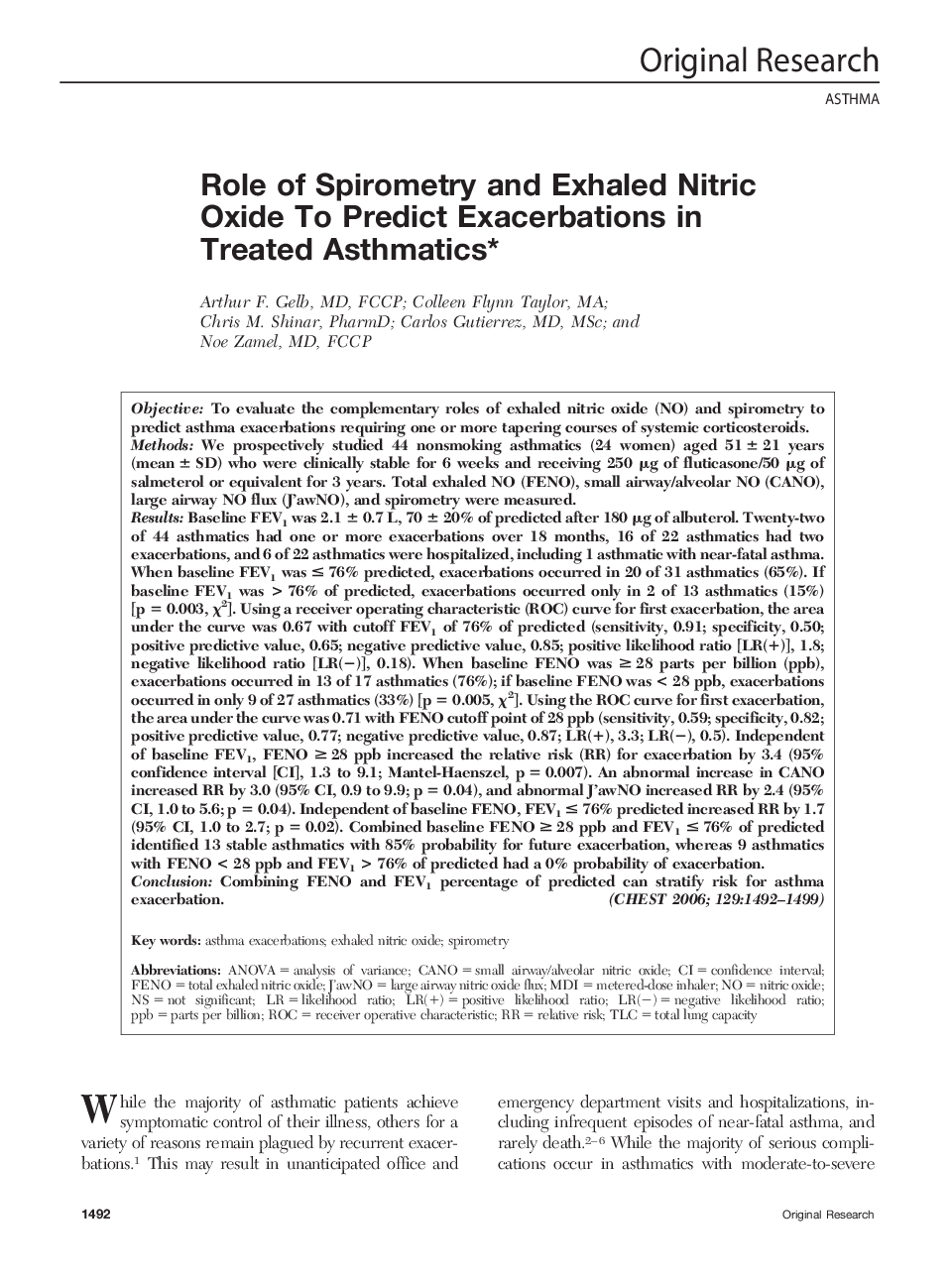| کد مقاله | کد نشریه | سال انتشار | مقاله انگلیسی | نسخه تمام متن |
|---|---|---|---|---|
| 2905939 | 1173439 | 2006 | 8 صفحه PDF | دانلود رایگان |

ObjectiveTo evaluate the complementary roles of exhaled nitric oxide (NO) and spirometry to predict asthma exacerbations requiring one or more tapering courses of systemic corticosteroids.MethodsWe prospectively studied 44 nonsmoking asthmatics (24 women) aged 51 ± 21 years (mean ± SD) who were clinically stable for 6 weeks and receiving 250 μg of fluticasone/50 μg of salmeterol or equivalent for 3 years. Total exhaled NO (FENO), small airway/alveolar NO (CANO), large airway NO flux (J’awNO), and spirometry were measured.ResultsBaseline FEV1 was 2.1 ± 0.7 L, 70 ± 20% of predicted after 180 μg of albuterol. Twenty-two of 44 asthmatics had one or more exacerbations over 18 months, 16 of 22 asthmatics had two exacerbations, and 6 of 22 asthmatics were hospitalized, including 1 asthmatic with near-fatal asthma. When baseline FEV1 was ≤ 76% predicted, exacerbations occurred in 20 of 31 asthmatics (65%). If baseline FEV1 was > 76% of predicted, exacerbations occurred only in 2 of 13 asthmatics (15%) [p = 0.003, χ2]. Using a receiver operating characteristic (ROC) curve for first exacerbation, the area under the curve was 0.67 with cutoff FEV1 of 76% of predicted (sensitivity, 0.91; specificity, 0.50; positive predictive value, 0.65; negative predictive value, 0.85; positive likelihood ratio [LR(+)], 1.8; negative likelihood ratio [LR(−)], 0.18). When baseline FENO was ≥ 28 parts per billion (ppb), exacerbations occurred in 13 of 17 asthmatics (76%); if baseline FENO was < 28 ppb, exacerbations occurred in only 9 of 27 asthmatics (33%) [p = 0.005, χ2]. Using the ROC curve for first exacerbation, the area under the curve was 0.71 with FENO cutoff point of 28 ppb (sensitivity, 0.59; specificity, 0.82; positive predictive value, 0.77; negative predictive value, 0.87; LR(+), 3.3; LR(−), 0.5). Independent of baseline FEV1, FENO ≥ 28 ppb increased the relative risk (RR) for exacerbation by 3.4 (95% confidence interval [CI], 1.3 to 9.1; Mantel-Haenszel, p = 0.007). An abnormal increase in CANO increased RR by 3.0 (95% CI, 0.9 to 9.9; p = 0.04), and abnormal J’awNO increased RR by 2.4 (95% CI, 1.0 to 5.6; p = 0.04). Independent of baseline FENO, FEV1 ≤ 76% predicted increased RR by 1.7 (95% CI, 1.0 to 2.7; p = 0.02). Combined baseline FENO ≥ 28 ppb and FEV1 ≤ 76% of predicted identified 13 stable asthmatics with 85% probability for future exacerbation, whereas 9 asthmatics with FENO < 28 ppb and FEV1 > 76% of predicted had a 0% probability of exacerbation.ConclusionCombining FENO and FEV1 percentage of predicted can stratify risk for asthma exacerbation.
Journal: Chest - Volume 129, Issue 6, June 2006, Pages 1492–1499